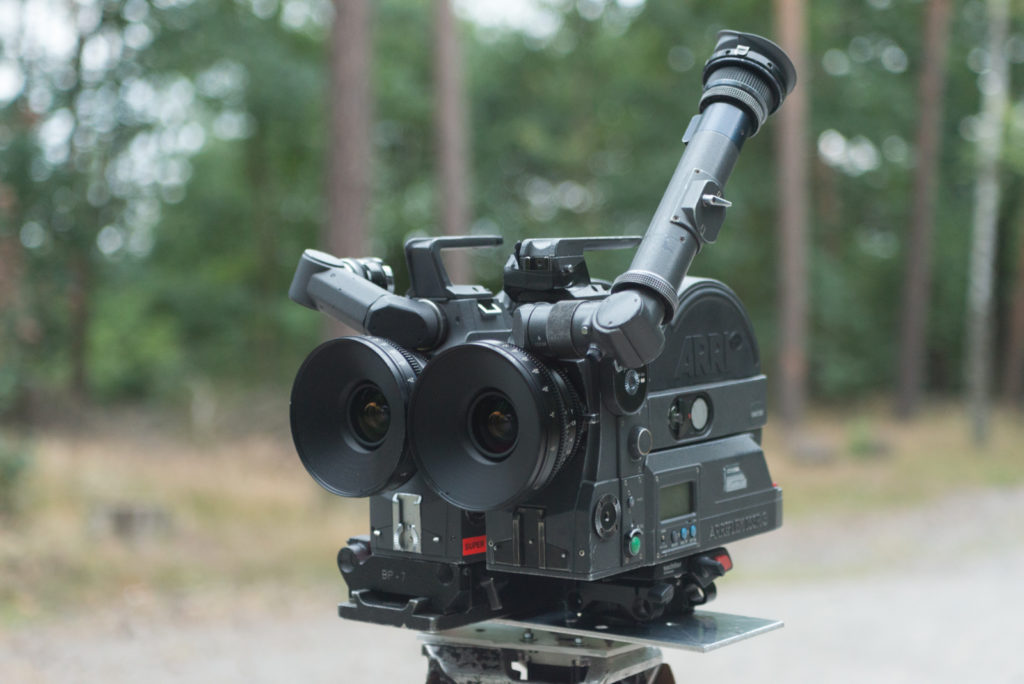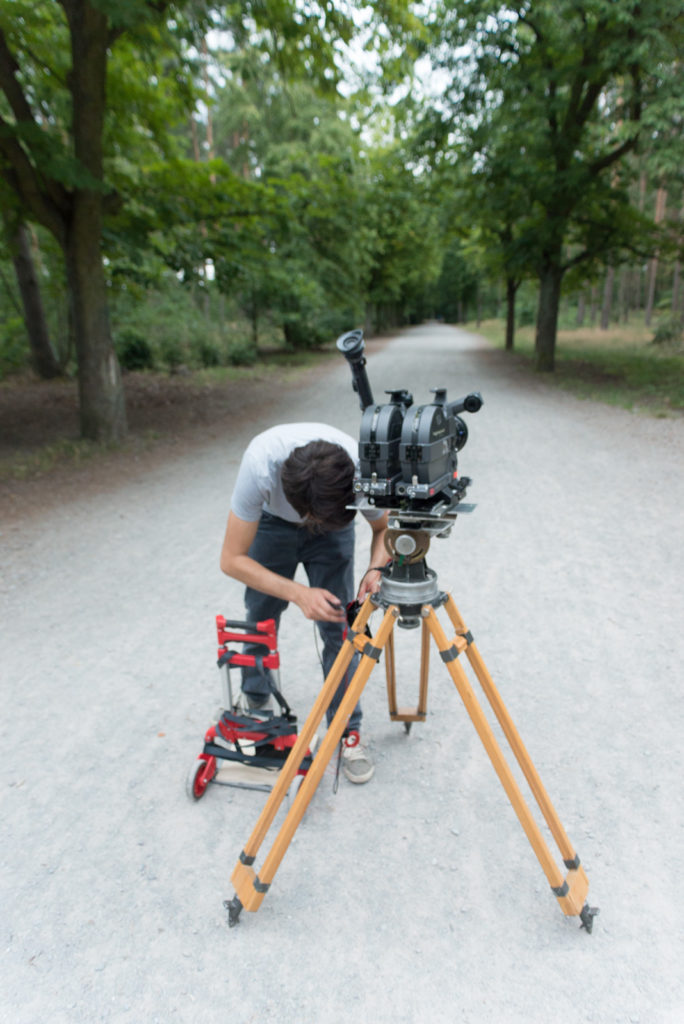En colaboración con Lucas Maia
La estereoscopia es comúnmente definida como una técnica que parece intentar responder a la necesidad tácita de querer hacer de la imagen bidimensional — desde su carácter figurativo y verosímil en su rol de ventana — algo más real para el espectador. Parece incluso que el aura tecnológica que envuelve cualquier desarrollo en este campo estuviera acompañada irremediablemente de una asunción que poco se discute: que la meta es hacer indiscernible la diferencia entre la pantalla y la realidad. Otros desarrollos paralelos dentro de esta carrera hacia la verosimilitud de la imagen dan cuenta de ello, como el promocionado 4D — que lejos de tratarse de algún avance en el entendimiento de la física, se vale solamente de sincronizar películas en 3D con efectos atmosféricos en la sala de la proyección —. Sin duda el marketing alimenta esta expectativa en el espectador de que, con sólo ponerse unas gafas, la realidad se expandirá más allá y más acá de la pantalla. Tal vez el marketing sea responsable de crear estas falsas expectativas con todo tipo de principio que depende del avance tecnológico, como la alta definición o la alta fidelidad, pero resulta difícil encontrar un caso más representativo de una técnica que se haya hecho tantas enemistades en este camino que la estereoscopia. Parece que la imagen estereoscópica está condenada a no ser suficiente ante la tarea que se le ha impuesto. Lejos de tratarse solamente de una respuesta o una alternativa a la predominancia de la visión monocular que ha prevalecido desde el renacimiento, la estereoscopia irremediablemente carga con la misión de satisfacer un sentido extraño de escapismo de las masas. Como si la realidad no fuera suficiente, los espectadores se vuelcan a las salas de cine en 3D a hacer una inmersión total en la película: no basta solamente con dejarse capturar por una narrativa, es necesario engañar los sentidos, percibir la profundidad, sentir que se está ahí. Sin duda, por tratarse de un valor agregado al cine — en muchos casos optativo — la estereoscopia como técnica subalterna no puede, ni podrá nunca, satisfacer las demandas del espectador que quiere caminar a través de la pantalla.
No es coincidencia que las últimas incursiones en la realidad virtual, como el Oculus Rift, partan de la imagen estereoscópica como principio técnico, pero es evidente que la idea de realidad virtual se distancia ampliamente del cine. En la pantalla grande, el 3D parece suscitar siempre dos tipos de reacción: o un entusiasmo ingenuo o una aversión inmediata, la primera por cuenta de esta esperanza de ver una realidad expandida, y la segunda por la convicción de que esta esperanza no será satisfecha. Resulta, en este contexto, una tarea liberar a la estereoscopia de esta carga, y poder verla en sus mínimos términos. El círculo, el triángulo, el rectángulo y el cruce es un intento por descomponer la imagen estereoscópica en sus partes esenciales, de forma analógica, sin su aura artificiosa de ser tecnología de punta. Seis proyectores en una estructura triangular crean una sola imágen en una pantalla frente a ellos: un giro en un cruce de caminos. Luego de haber grabado el movimiento con dos cámaras posicionadas una junto a la otra — simulando la separación entre los ojos como en el cuerpo humano —, cada una de estas películas fue descompuesta en tres canales — rojo, verde y azul, o RGB por sus siglas en inglés—. Las películas correspondientes a cada una de las cámaras fueron polarizadas de modo tal que sólo se pueden ver a través de un lente de las gafas 3D, es decir, por el ojo izquierdo el espectador puede ver solamente las proyecciones de la cámara izquierda e igualmente para el ojo derecho. El resultado es una imagen compuesta sin reparo por la sincronización: cada proyector funciona en una frecuencia específica a pesar de que el estándar sea 24fps, por lo cual siempre existirá un desfase, y la imagen perfecta se logrará eventualmente, cuando los seis proyectores se sincronicen en el tiempo circular que crea el loop, solamente para desincronizarse de nuevo inmediatamente.
¿Qué es la estereoscopia? En este contexto resulta difícil afirmar que se trata solamente de una técnica, pues existen muchas formas de lograrla, incluso por fuera del dominio de la óptica — en cuanto a lo referente a la creación de la imagen que se observa—. ¿Es un ideal? ¿un objetivo? Parece que la cuestión apunta más a la visión binocular y a la idea de profundidad, pero en todo caso queda mucho por abordar. La estereoscopia pone sobre la mesa el tema mismo de la realidad, el engañar los sentidos, la necesidad de aumentar la pantalla y la frustración inherente a no lograrlo. Es como si planteara una encrucijada: o andar por el camino del escepticismo, o avanzar por el de la experimentación.
THE CIRCLE, THE TRIANGLE, THE RECTANGLE AND THE CROSSING
Stereoscopy is commonly defined as a technique that seems to try to address the implicit need of wanting to turn the two-dimensional image — seen from its figurative aspect as a window into space — into something more real to the spectator. It even seems that the technological aura that involves any development in this area comes out of an assumption that is not often discussed: That the goal is, indeed, to make it impossible to distinguish between the screen and reality. Other parallel developments within this race towards verisimilitude are also proof of this, like the so called 4D cinema which, far from being some sort of advancement in our understanding of physics, relies on synchronizing 3D films with atmospheric effects inside the projection room.
Certainly, marketing feeds the expectation in the spectator that only through the act of putting on some glasses will reality suddenly be expanded beyond the screen. Perhaps marketing is responsible of having created this false hope with all sorts of principles that depend on technological advances, like high definition or high fidelity, but it seems that stereoscopy is, in this context, the one that has made more enemies along the way. It seems as if the stereoscopic image is condemned to be insufficient vis-à-vis the task that has been imposed on it. Far from being just an answer or an alternative to the predominance of monocular vision that has prevailed since the Renaissance, stereoscopy is irremediably charged with the task of satisfying some kind of need for escapism among the masses. As if reality were not enough, spectators run into the 3D movie theaters to participate in a full immersion into the movie: It’s not enough to be engaged in a plot, it’s necessary to trick the senses, to feel the depth, to really believe that one is there. Undoubtedly, as an aggregate value to cinema — often just optative — stereoscopy, in its condition of subordinate technique, will never be able to satisfy the demands of the given spectator who hopes to be able to walk through the screen.
It is no coincidence that the last incursions into virtual reality, such as the Oculus Rift, use stereoscopy as a technical starting point, but it is evident that the idea itself of virtual reality differs substantially from that of cinema. In the big screen, 3D seems to always trigger one of two kinds of reactions: A naïveenthusiasm or an immediate aversion. The former given the hope of perceiving an expanded reality and the latter due to the conviction that this expectation will not be satisfied. In this context, liberating stereoscopy from this burden and appreciating it in its most basic form ends up being a difficult task.
The Circle, the Triangle, the Rectangle and the Crossing is thus an attempt to decompose the stereoscopic image into its essential parts, in an analogue way, without its aura of being spearhead technology. Six projectors in a triangular structure create one single image in a screen in front of them: A crossing of roads. After having filmed the movement with two cameras situated one next to the other —simulating the distance between the eyes as in a human face —, each of these films is separated into three channels —red, green and blue, or RGB—. The films of each camera are polarized in a certain way, so that they can only be seen through one of the lenses of the 3D glasses, i.e., through the left eye one can only see the three projectors that carry the film of the left camera and vice versa. The result is an image that is composed without concern for synchronization: Each projector runs at a specific frequency even though the standard is 24fps, which implies that there will alway be a delay between them. The perfect image will eventually be achieved when all six projectors synchronize in the circular time that the loop creates, only to fall out of synch immediately after that.
What is stereoscopy? In this context it’s hard to proclaim that it is only a technique, since there are several ways to achieve it, even outside the domain of optics — in relationship to the creation of the image that will be observed —. Is it an ideal? An objective? It seems that the question revolves more around binocular vision and the idea of depth, but there is still much more to consider. Stereoscopy questions the topic of reality, tricking the senses, the need for augmenting the screen and the inherent frustration of not making it happen. It is like a crossing: one can either walk down the path of skepticism or down the path of experimentation.


El círculo, el triángulo, el rectángulo y el cruce (The Circle, the Triangle, the Rectangle and the Crossing)
6 16mm projectors running in loop with polarized filters, a metal structure and a screen
186 x 215 x 60cm
2016, Universität der Künste, Berlin.


Making of





Studio Fischer el Sani
2016, Berlin.




Mono No Aware X
2016, New York.


2017, Völksbühne, Berlin.





